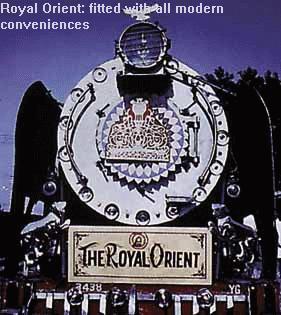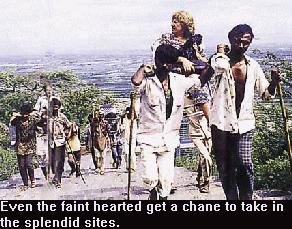

![]()
 A
holiday aboard India’s Royal Orient Train, often compared to Europe’s
Orient Express, is a combination of spectacular sight seeing and impressive
facilities.
A
holiday aboard India’s Royal Orient Train, often compared to Europe’s
Orient Express, is a combination of spectacular sight seeing and impressive
facilities.
The Delhi Cantonment, a quaint little railway station on the outskirts of the Indian capital is enveloped in a thick winter fog that has descended upon it. It is a Wednesday afternoon in December. The motley crowd of the 22 tourists from a number of European countries waits to board the luxury train, the Royal Orient, an Indian version of the much-romanticised Orient Express that puffed its way from Europe to Asia across locales that were the perfect setting for adventure, mystery and fun. The Royal Orient’s attendants, with saffron-coloured turbans perched on their heads, greet the tourists and escort them to their respective cabins on the Royal Orient.
This is the starting point of our seven day journey on what has been widely publicised as a train that offers the "ultimate in luxury" ( to quote the Tourism Corporation of Gujarat that has organised this project in co-operation with the Indian Railways). It will journey from Delhi through the states of Rajasthan and Gujarat, and bring us back to the Delhi Cantonment in the early hours of the eighth day.
The Royal Orient is fitted with all the modern conveniences - air- conditioned ambience that keeps the temperature down to 15 degrees, running hot and cold water, a separate bath room assigned to the occupants of each cabin clean and comfortable cabins that are regularly tidied and cleaned by the attendants, etc. The interior of each car is fitted with exquisite Indian decor depicting the culture and history of the country.
According to S.A.Khan, the Managing Director of the Frankfurt-based travel agency Asra Orient Reisen GmbH. the largest selling agency for the Royal Orient on continental Europe, the train enjoys increasing popularity among German tourists, although it is also catching on with other Europeans.
The call at Chittor Rajasthan, early next morning evokes considerable amusement among the tourists. Hordes of monkeys, including a couple of newly-born babes clinging to their mothers and quite oblivious to the amused tourists staring at them, appear from nowhere. These are the notorious langoors - curious black faces with agile grey-coloured bodies and long tails, follow us closely at every nook and corner of the Chittor Fortress, hoping to get some chanas, the dry, roasted chick peas that are sold to tourists in small transparent plastic bags.
Our next stop is Veraval on the Arabian Sea; we soon get accustomed to the stench of the salted dry fish in and around the Veraval station. We head for the legendary temple of Somnath, one of the 12 most sacred shrines of Shiva.
According to legend, Somnath temple was built by none other than Soma. The temple was destroyed seven times, and seven times was it rebuilt. Mohammad of Gazni, who had heard of its fabulous treasure, raided it in 1026 and carried away camel-loads of jewels and gold.
Our next stop is Delwada, the entry point to Daman and Diu, the former Portuguese enclaves, in the state of Gujarat. Diu a tiny island off the extreme south of the mainland is still a secluded beach resort near a colonial town of great charm, with whitewashed churches and tile-roofed villas. The St Paul’s Cathedral a remnant of the Portuguese colonial past, has a neat and clean look, contrasting sharply with the ruinous condition of the old Portuguese fort facing the sea. The Magico Do Mar a quaint Portuguese hotel that offers the solitude of a Robinson Crusoe beach along with what are the indispensable trappings of modern civilisation, provides us some shelter from the blazing sun. We sized up our next morning’s rigour as our guide prepares us for the ascent to Palitana, the temple city with an incredible 863 temples carved out of white marble atop the Shatrunjaya Hills. These temples were built over a period of 900 years. Poets have likened these temples carved in exquisite marble to "prayers in stone"
The most important of these is the temple of the first Teerthankara, the patron sage of the Jain faith, an ascetic religious minority in India’s diverse religious canvas. At the other end is the original shrine of the first sage Adi Nath.
 If
you are too faint-hearted to walk up the 3,572 steps - an ascent of four
Kilometers - you can be carried up for two hours in aluminium chairs strapped
on two bamboo poles by four men. You have to see the temples to experience the
combined emotions of beauty, solemnity and tranquillity.
If
you are too faint-hearted to walk up the 3,572 steps - an ascent of four
Kilometers - you can be carried up for two hours in aluminium chairs strapped
on two bamboo poles by four men. You have to see the temples to experience the
combined emotions of beauty, solemnity and tranquillity.
From Palitana, we are taken to Sarkhej with its Vishalla Village which has become the largest museum of pots, pans and other tools used for cooking. The entire area, lit by lanterns at night is an enchanting sight. The next morning is spent in Ahmedabad, the heartbeat of India’s textile trade. Named after a Muslim ruler who founded it in 1411, Ahmedabad has the Mahatma Gandhi ashram - the place where India’s non-violent freedom fighter set up a simple retreat in 1915. It was from here in 1930 that Mahatma Gandhi began his famous Dandi March to the sea to protest against the salt Tax imposed by the British.
Our last day is spent in Rajasthan’s capital Jaipur, appropriately called the "pink city" because of the cluster of pink coloured buildings and monuments that dot the city.
-Friday
Continue to Plus page 6 - All at sea: fishermen arrested by the Indian Coast Guards
Return to the Plus contents page
![]()
| HOME PAGE | FRONT PAGE | EDITORIAL/OPINION | NEWS / COMMENT | BUSINESS
Please send your comments and suggestions on this web site to
info@suntimes.is.lk or to
webmaster@infolabs.is.lk